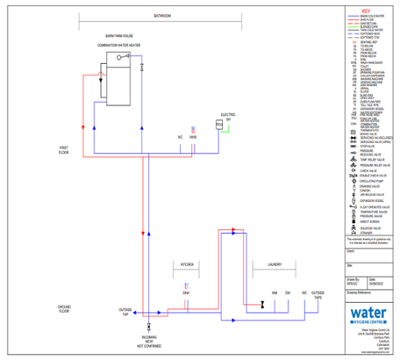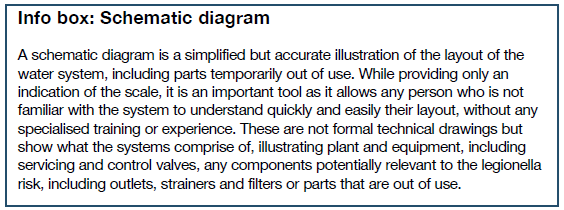Schematic drawings are an important and integral part of the tools you have available to you when preparing your Water Safety Plan and Written Scheme of Control. They are often left undisturbed and outdated, only being looked at when needed when the current Legionella Risk Assessment is being reviewed, when there is an issue, or when a positive Legionella lab result is received and needs to be addressed.
What Does the Guidance Say? Key Insights Explained
BS8580-1 2019 Annex G gives an informative guide as to what the schematics are to include, and the level of detail required for them to be deemed “suitable and sufficient”.
“Schematic diagrams are accurate but simplified illustrations of the configuration of water systems, which include all key components and relevant components and omit everything which is not relevant.
They are not formal technical drawings and are intended to be easy to read without specialised training or experience. Like maps of underground railways in many cities, they allow the person unfamiliar with the layout of a system to quickly understand the relative positions and connections of the relevant components, whilst providing only an indication of the scale.”
HSG274 Part 2- Section 13 shows an Info box with a descriptive overview.
Why are Schematic Drawings so important for managing Legionella?
Up-to-date schematic drawings should be readily available to all members of the Water Safety Group, and all those involved in working on water systems. This includes CPs (Competent Persons) and contractors, to be able to understand the water system(s) they are working on when planning and carrying out planned maintenance, temperature monitoring, Legionella sampling, carrying out Legionella Risk Assessments, or carrying out investigatory works.
Working on a domestic water system and not having sight of up-to-date, accurate schematics is effectively working blind, which will compromise the effectiveness and levels of assurance that are being sought. Schematics are often part of the scope to be delivered when conducting your Legionella Risk Assessment, however, this often attracts an additional cost for the extra work required so this needs to be considered when commissioning an assessment.
Considerations when commissioning Schematics
When commissioning someone to conduct a review of your current schematics or generate a new schematic, it is important that the service provider is competent and has in-depth knowledge of Legionella control and associated potential hazards from water systems.
 Undertaking a site survey to produce accurate and up-to-date schematics is not always straightforward and problems are often encountered because of out-of-date building plans, limited access to certain areas such as patient isolation rooms or prohibited areas that contain ACM; Asbestos Containing Materials.
Undertaking a site survey to produce accurate and up-to-date schematics is not always straightforward and problems are often encountered because of out-of-date building plans, limited access to certain areas such as patient isolation rooms or prohibited areas that contain ACM; Asbestos Containing Materials.
Should any areas be missed or omitted from the survey, this detail must be recorded on the drawings produced. The level of detail required can also vary, for example, in a Healthcare environment, as stated in HTM-04-01 Safe Water in Healthcare Premises, the level of detail is expected to be enhanced showing all valves and relevant water systems in as much detail as possible, whereas a simpler system such as a small office building where the risk is deemed to be lower would show less detail.
The info box in HSG 274, as shown above, is an example of what would be required. Once you have a suite of up-to-date drawings, keeping them updated can be challenging, particularly in large or complex systems such as a hospital. Your schematics need to be reviewed and updated when any significant changes to the system have occurred, this may be Capital Project works, refurbishments, or the change of use of an area that impacts the function or use of an existing water system.
Recording these updates is often missed due to not having access to or the training required to use the software used to amend computer-generated schematics, that said, handwritten entries on a drawing are better than no information being recorded.
Conclusion.
The importance of up-to-date and accurate schematic drawings cannot be emphasised enough. When correct, they give invaluable oversight of your water systems that provides you and your team confidence and assurance that you have the correct information to hand when needed to effectively manage any potential Legionella risk or other water-borne pathogens.
Feel free to reach out if you have any questions about the issues mentioned above or if you would like to consult with one of our experts on water hygiene.
Editors Note: Please note that the information provided in our blog post is accurate as of its original publication date in January 2024.
© Water Hygiene Centre 2024










